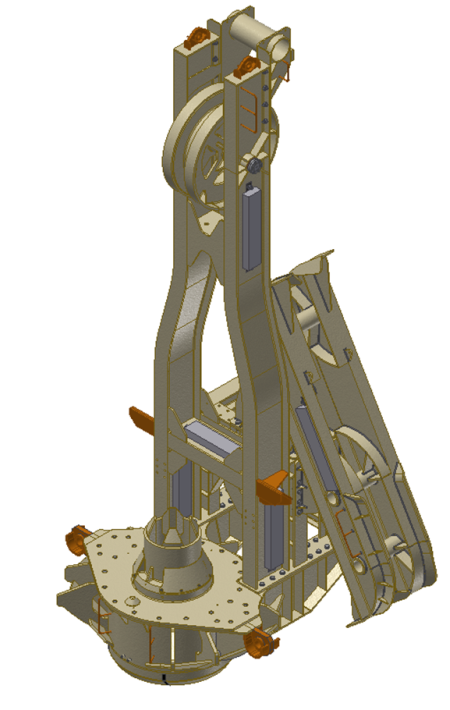Introduction
Balltec was commissioned by Subsea7 to design, manufacture, build and test 36 top tether connectors for Buoyancy Supported Riser buoys (BSR buoy) moored 300 km off the coast of Rio de Janeiro. One of the major elements of the top tether connector assembly was the chain management structure. As part of this project, Balltec asked Wilde Analysis to investigate the stresses generated in this tower-like support structure when the chain’s offset position created high moment loads during service. Wilde Analysis was also contracted to conduct all the FE analysis on this exciting and first-of-its-kind top tether connector and linear chain tensioning system.
Company

Balltec was established in 2004. It designs and manufactures high load, high integrity mechanical connectors for application in the oil, gas and renewable industries. Core products include tools for mooring, pipeline recovery, heavy lifting and diver-less bend stiffener connectors. All of its products are manufactured, assembled and tested from the head office and workshop facility in Morecambe, Lancashire. It also has a base in the USA.
Balltec has more than 25 years’ experience of pioneering and development of ball and taper technology for the oil and gas industries. Its engineers have always placed a strong emphasis on research and development, initially with the ball and taper mechanism which has been diversified to accommodate a range of applications. They continue to develop new and innovative subsea products both with and without ball and taper.
Background
Balltec was commissioned by Subsea7 to design, manufacture, build and test 36 top tether connectors for 4 Buoyancy Supported Riser buoys (BSR buoy) moored 300 km off the coast of Rio de Janeiro. The buoys were positioned over the Guara and Lula pre-salt fields in the Santos basin.
One of the major elements of the top tether connector assembly was the chain management structure. This was designed to handle the excess chain once it had been tensioned via Balltec’s subsea tensioning unit. Part of the chain management structure’s job was to ensure that the chain tail did not interfere with the locking dogs during service. This meant that the chain had to be offset from the centre of the connector, creating high moment loads on the structure.
Challenge
The chain management structure was designed to handle excess chain exiting from the chain tensioner system. The tensioning system was used to tension and equalise loads in the mooring chains which react against the buoyancy of a large submerged buoy and thereby hold it in place.
After the excess chain was passed through the tensioning system, it was looped over the idler wheel, before being led through the chain chute and left to hang as a dead-weight. The total chain length was 83m with a mass of 525Kg per metre.
Balltec asked Wilde Analysis to predict and assess the stresses generated in the tower when subjected to loads created by the chain under operational conditions.
In addition, the analysis included an investigation of the stresses generated in the idler pin assembly when subject to loading from the chain configuration. Calculations were also performed on the load-carrying capacity of the bolted interfaces.

Solution
ANSYS FEA software was used for the analysis due to its robust capabilities for non-linear structural analysis, involving complex challenging contact between parts.
For maximum accuracy and efficiency, the model was developed using a combination of shell and solid elements. For the bolted interfaces, the bolts were explicitly included along with non-linear frictional contact between mating flanges to ensure that the interface loads were accurately captured. In parallel, manual calculations of the load carrying capability of the bolt group were undertaken.
Non-linear frictional contacts were also used between the chain and idler wheel. This allowed the chain to slide over the mating surface but with some resistance to motion.
The powerful multi-body part capability in ANSYS enabled the most efficient model setup, analysis run time, and post processing to be achieved and the iterative solver was used to calculate the final stresses and displacements.

Business Benefits
The simulations undertaken by Wilde Analysis provided Balltec with the confidence that:
- All components of the fabricated tower structure experience stress levels below the allowable values with a safety factor of 1.3
- All components in the idler pin sub-model experience stress levels below the allowable values with a safety factor of 1.3.
- All bolts experience tensile, shear and/or combined forces that are within the limits specified by BS 5950-1-2000.
The project enabled Balltec to gain a more detailed understanding of the Chain Management Structure during the development stage. It also avoided many potential problems, resulting in significant savings by eliminating wasted re-design and testing time, with knock-on effect on budgets and final delivery schedules to the end client. In addition, the work provided a valuable insight into the advanced capabilities of ANSYS.
Wilde’s engineers are very knowledgeable, are always very generous with information and tell us exactly what we need to know. We get a lot more value for money from Wilde than we would normally expect – they go well above and beyond the usual limits to help us.
They have been instrumental in helping us develop and gain a more detailed understanding of new products during the development stage. By using their R&D services at an early stage, we can head off a lot of problems resulting in very beneficial savings.
By running this development step with Wilde consulting services we can be very confident going into the first physical prototype test with a very predictable and thoroughly understood the product.
Balltec